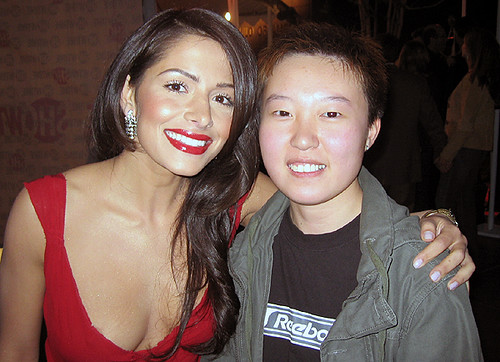the great paris centennial exposition of 1889 fielded a new wonder of the world, the eiffel tower. this is no surprise to anyone reading this, i'm sure. let's quickly review the "grand moment", though:
On June 10, Eiffel held his grand opening, squiring royalty to the top, including tours of his private apartments. In the coming weeks, guests to to the tower included the Shah of Persia, the Prince of Wales, the King of Siam, the Bey of Djibouti, the President of France, Buffalo Bill and Thomas Edison. Young women purchased special dresses made for the occasion called Eiffel ascensionniste. Over 1.9 million people came to the tower during the Exposition.the shah mentioned above was the last qajari shah before the europeans propped up a military man as the new founder of the pahlavi dynasty, but there remains a qajari contender: texas-raised actress sarah shahi of the l-word (role: carmen de la pica).The tower left behind a lasting legacy. Today, the Eiffel Tower still gets twice as many visitors as the Louvre. The tower was used extensively by Eiffel over the next years as a serious science instrument. Working with the French Central Weather Bureau, Eiffel installed thermometers, barometers, and anemometers. Later, Eiffel's began experimenting with aerodynamics, building the world's first reliable wind tunnel in the tower.

clearly, she's my favourite cast member - wish i were the nice dyke standing in the photo with her.
but i digress. what surprised me was learning that there was a remarkable contender project created by jules bourdais (1833-1913) and his team, the phare de paris or "pharos of paris", named for the famous lighthouse of alexandria - and the wealthy quarter it engendered.
also called le tour du soleil "tower of the sun", bourdais' design was intended to light up the entire city at night using arclights.
imagine the difference it would have made if the phare de paris had been made instead, lighting up the city of paris at night. not necessarily a great idea, the lighting, but when needed, incredible. besides, the eiffel tower is ugly as sin, and the phare looks like it would have been just gorgeous (light pollution aside).Although Eiffel won the tower competition, there was another serious contender. Electricity and lighting was the key technology during this period. Edison's carbon filament lamp was first made public at the Paris Electricity Exposition of 1881. Up till then, electric lighting was all arc lighting. [Schivelbusch, p.58]
In the period 1880-1920, electricity "permeated modern urban life". The applications of this general purpose infrastructure were astounding: electroshock therapy in medicine; electrocultured galvanised plants in agriculture; local traffic systems; lifts; telephones; radio; the cinema; and, of course, countless household appliances.
Arc lighting was quite popular in the United States. Detroit had 122 towers lighting 21 square miles. Cities ranging from San José to Flint, Michigan all built huge arc lighting towers. A young French electrical engineer named Sébillot toured the United States and was hooked. When the 1889 Exposition committee launched a competition for a "monumental landmark," Sébillot teamed up with the architecht Jules Bourdais.
In 1885, the team submitted a proposal for a 360 meter Sun Tower. Designed to light "tout Paris", the tower was one of two that were submitted to the competition. The other was by a bridge designer, Gustave Eiffel. Why did the Sun Tower lose out? It was that "the light would dazzle rather than illuminate," blinding viewers with its glory.
oh, i should also mention another qajari contender: marjane satrapi, direct descendent of the last qajari shah. she's the author of persepolis and persepolis II.
No comments:
Post a Comment